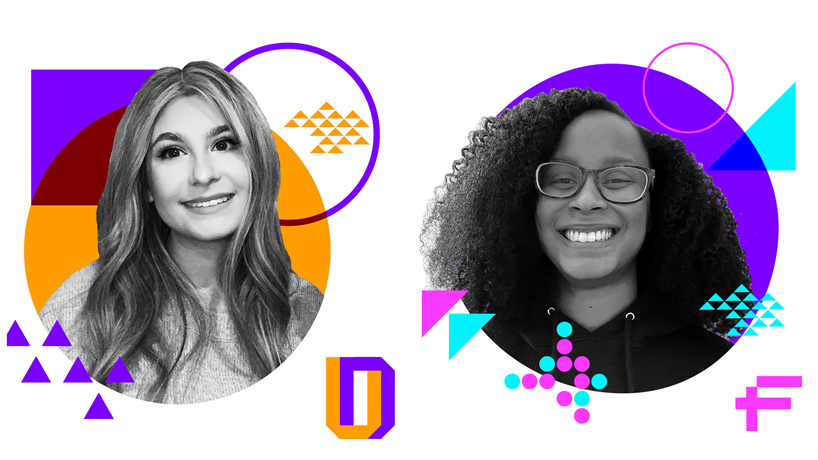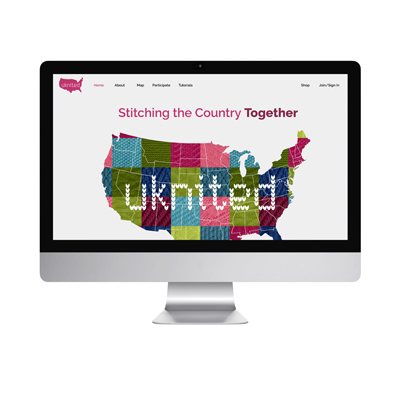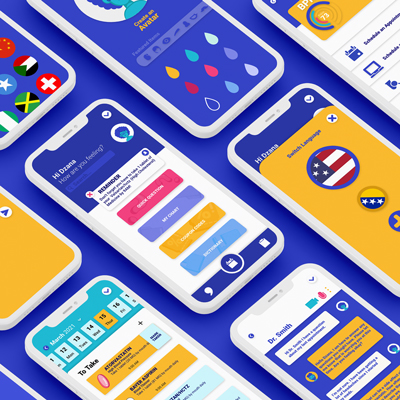
Dzana Parla (left) and Faith Ferguson (right) were two of the 20 senior graphic design students who launched a social media campaign to promote the virtual Senior Graphic Design Thesis Night. For their capstone projects, Parla designed a mobile phone app to help non-native English speakers navigate the healthcare system, and Ferguson created a concept for a nationwide knitting project to remember those lost to COVID-19 or missed during quarantine. (Photos courtesy of Scott Gericke)
Around this time last year, Scott Gericke was scrambling to salvage the annual Senior Graphic Design Thesis Night.
The two-night showcase for University of Missouri–St. Louis graphic design students had to be called off at the last minute due to the emerging COVID-19 pandemic.
Gericke, an assistant teaching professor in the Department of Art & Design, along with Jennifer McKnight, associate professor, and their students adapted quickly, though. The class used the next four weeks to create a website to feature their senior capstone projects: https://designhaspurpose.com/.
Luckily, this year, preparations for the final presentations were less hectic.
The seniors went into the spring semester knowing they would take a digital approach. The projects are still centered around the idea that “design has a purpose,” and they are being displayed on the website again.
“The goal is that we’re going to continually keep the theme, and each year the students reinterpret it,” Gericke said. “What’s great about this class is that they developed a whole social media campaign.”
The students created Facebook, Instagram and LinkedIn accounts to promote the two-night showcase held via live webinar on March 12-13. For 20 days leading up to the first night, the accounts featured one student a day. Posts on each platform included biographical information, design interests, previews of the final projects and links to the students’ portfolios.
To launch the campaign, the class split into three groups. One group handled branding for the event and another created the social media accounts and pushed out posts. The final group worked on updating the website.
Gericke said it not only spread the word about the event but also provided an opportunity for students to promote themselves and their work as they prepare to enter the job market.
“It’s been so successful that we’re going to build it into the senior experience every spring semester,” Gericke said. “They’ve laid the groundwork.”
In previous years, students have presented their projects in person to a crowd of alumni, family and industry professionals at the Blanche M. Touhill Performing Arts Center. This year, each student made a 10-minute live presentation on Zoom.
Despite the change in format, Gericke noted that more than 100 people tuned in to the presentations. College of Arts and Sciences Dean Andrew Kersten was one of many from the UMSL community in attendance.
“I was there for both of them, and on the second night, my family joined me to watch it,” Kersten said. “It was riveting and very inspiring. I’m constantly amazed at their innovative spirit.”
Representatives from high-profile advertising and marketing agencies, such as HLK, Moosylvania and New Honor Society, also attended.
“Frankly, we’ve gotten so many people saying ‘Hey, we’re hiring this year, and we really want to meet your kids,’” Gericke said. “So that’s really, really great.”

Faith Ferguson’s project, “Uknited: Stitching the Country Together,” was inspired by the AIDS quilt and her experience during the COVID-19 pandemic.
The seniors’ projects covered a wide variety of topics. Faith Ferguson created a concept for a nationwide knitting project called, “Uknited: Stitching the Country Together.” People would order a kit and knit a square for someone lost to COVID-19 or someone missed during quarantine.
Ferguson was inspired by the AIDS Quilt and her experience during the pandemic.
“I was inspired by my own mother,” she said. “Last August, she tested positive for COVID-19, and I had to take care of her for the first few weeks of school. She recovered, thankfully, but it was such a stressful time for me and the rest of my family. While I was in self-isolation, I started knitting a pair of mittens for her, which helped me relieve my anxieties about the unknown.”
Dzana Parla set out to help non-native English speakers navigate the health care system with a mobile phone app. She designed examples of the user interface, which included features such as a place to store medical information, medical definitions, schedules and a simple language translator.
Like Ferguson, Parla was also inspired by her family.
“The reason I did this was because of my dad,” she said. “I noticed he wasn’t going to the doctor as much as he should. He ended up having a bad health problem that could have cost him his life. He wasn’t going for two main reasons. One, his English wasn’t too great, so it was hard to understand and two, because it was expensive.”
They both felt nervous to present but were confident in their work.

Dzana Parla’s project, “Hey, Doc,” was inspired by her dad who has often had difficulty communicating with health care professionals as a non-native English speaker.
“I think my project turned out great,” Parla said. “I think it’s one of my favorite projects yet. I was able to achieve all of my goals for the app.”
Ferguson and Parla are currently looking for full-time jobs after graduation. Ferguson wants to work in branding, while Parla is open to a position in branding or user interface and experience design.
Ironically, for all their talent in the field, neither intended to study graphic design when they entered college. Parla initially gravitated toward marketing but found what she liked most was adding creative touches to her projects. A friend suggested exploring graphic design, and she never looked back.
Ferguson started college in the UMSL/Washington University in St. Louis Joint Undergraduate Engineering Program, but after a year of math and science classes, she realized engineering wasn’t for her. She changed her major without knowing much about the graphic design program – just a feeling that it was what she wanted to do.
The gamble has clearly paid off, though.
“I wondered what I could change my major to, and I thought about a graphic design class that I took in high school,” she said. “I did pretty well in that class, so I thought, ‘Maybe I’ll change my major to graphic design.’ It was one of the riskiest things I’d ever done, and I don’t regret it.”














